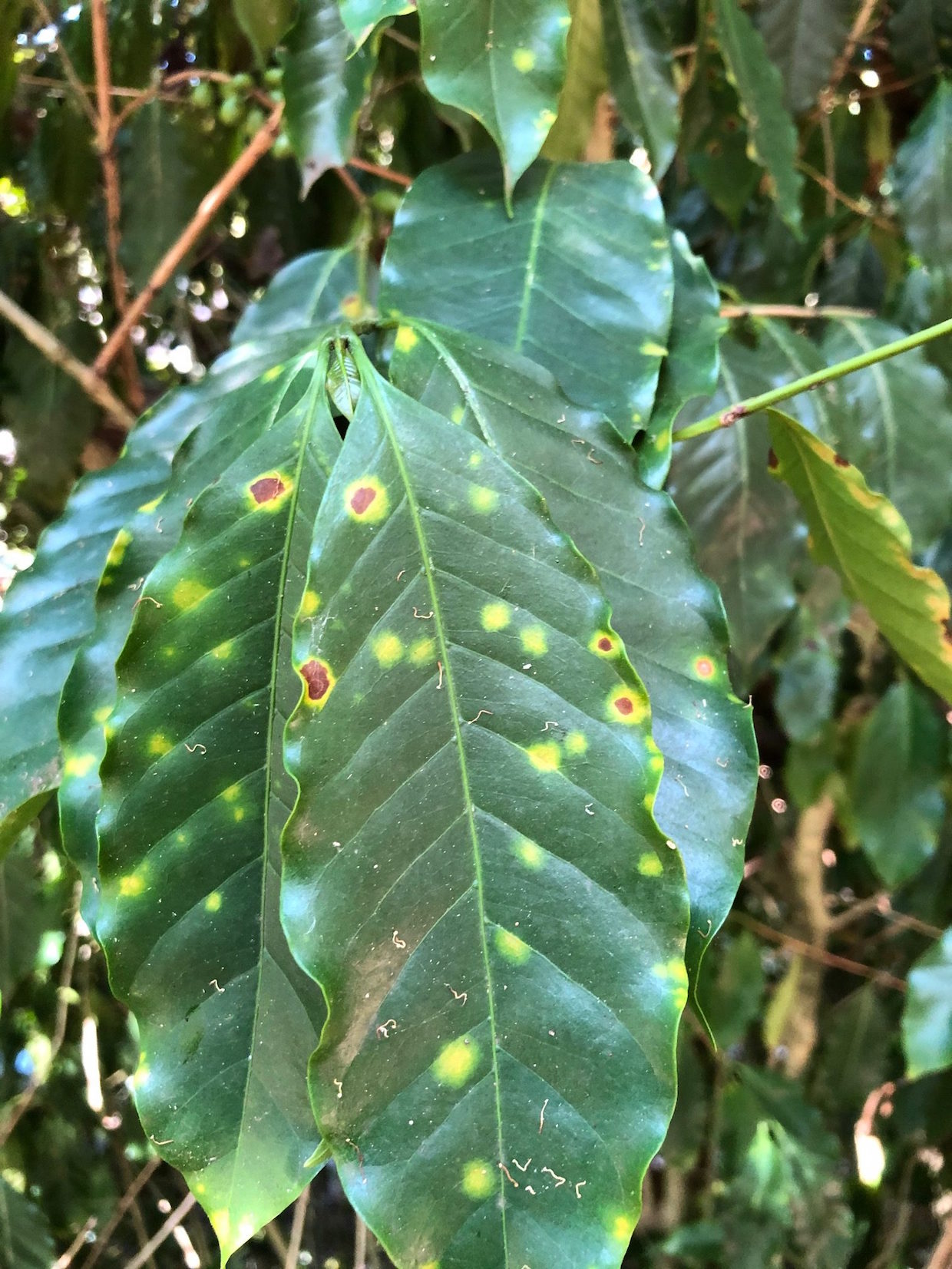
A coffee plant showing leaf rust spots on Hawaii Island. November 2020 press photo from the Hawaii Board of Agriculture.
Legislators in Hawaii have proposed a bill that could expand federal research funding for the Hawaiian coffee sector, which for the first time ever has been hit by the destructive plant disease coffee leaf rust (CLR).
Introduced by United States Sens. Mazie Hirono and Brian Schatz, alongside U.S. Reps. Ed Case and Kaialiʻi Kahele, the bicameral legislation would free up federal funding for research into pests and diseases affecting the production of both coffee and macadamia nuts.
In the case of coffee, the proposed Coffee Plant Health Initiative Amendments Act (CPHIAA) would amend the Coffee Plant Health Initiative (CPHI), which was part of the Agricultural Act of 2014 (a.k.a. the Farm Bill).
While the CPHI for the first time freed up federal funds for research into one of Hawaii’s longstanding natural foes, the coffee berry borer (CBB), the amendment would cover a broad range of additional pests and diseases.
The timing of the proposed legislation is especially important, as Hawaiian coffee farmers have experienced a widespread outbreak of leaf rust, which was first identified inside the state in October of 2020, and has since been confirmed on all of Hawaii’s major islands.
Related Reading
- Coffee Leaf Rust Discovered on All Major Islands of Hawaii
- WCR Closes Global Coffee Monitoring Program, Ramps Up Breeding Investments
- The Lasting Impact of Coffee Leaf Rust: Past, Present and Future in the Fight Against Fungus
“As our agricultural community continuously fights new invasive pests, resources provided by these two bills would be instrumental in protecting two of Hawaiʻi’s signature crops: coffee and macadamia nuts,” Sen. Hirono said in an announcement of the proposed bills. “I look forward to working with my delegation colleagues on these bills so that our producers are equipped to face current and future threats to these crops.”
The legislators estimate that the annual farmgate value in Hawaii of macadamia and coffee combined is somewhere “over $100 million.” The Hawaii Coffee Association (HCA), which has expressed its support for the bill, has estimated that the market value for Hawaiian green coffee in the 2019-20 year was $102.91 million.
“This important legislation enables the targeting of resources toward the most immediate threats facing coffee in Hawaiʻi today,” HCA President Chris Manfredi said in the announcement. “In addition it is forward thinking by anticipating future threats and enables researchers to quickly pivot as they emerge. We thank the introducers, sponsors and supporters of this measure as it will greatly contribute to the survival of one of Hawaii’s most important crops.”
In a statement shared with Daily Coffee News, Vern Long, the CEO of the agricultural research nonprofit World Coffee Research, suggested that the devastation caused by leaf rust that spread throughout the Americas in the last decade may have been far less severe if more research funding were allocated.
“The challenges posed by coffee pests and diseases in lower-capacity countries also pose risks for U.S. producers in Hawaii and Puerto Rico,” Long said. “Coffee growers in Hawaii faced this first-hand in 2020 when coffee leaf rust arrived on the islands. Coffee leaf rust devastated communities across Central America over the past 10 years, and had there been a robust global research effort during that period, Hawaii’s growers — and Central American growers — would likely be in a very different position today.”
Nick Brown
Nick Brown is the editor of Daily Coffee News by Roast Magazine.
Comment
1 Comment
Comments are closed.






Coffee Leaf Rust a decease first found in South Asia, particularly in Sri Lanka & India, which eventually converted to growing another variety ‘Robusta’ a sturdy plant which produces a slightly bitter tasted beans. Later Sri Lanka shifted to growing of Tea, while India produces both.
We have two plantations in Karnataka, Southern India, where we produce both Arabica & Robusta whivh are ‘Rainforest Alliance’ certified.
By and large, India has remarkably controlled the leaf rust which affects only Arabica plants, by replanting with newer strains and also by spraying Bordeau mixture.